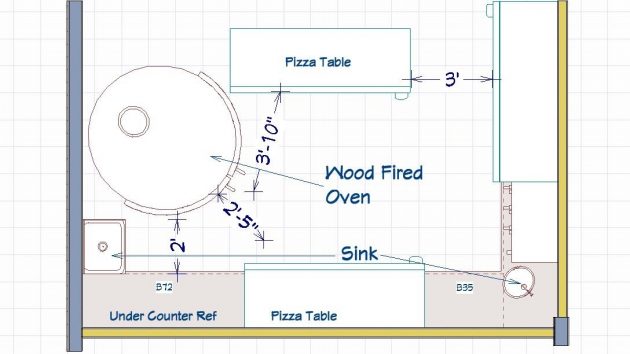
Creating your kitchen layout
By Maurizio Mascioli
Features Business and Operations Premises kitchen design kitchen layout maurizio mascioli Think of the sections of your pizzeria as flowing into one another: entrance of venue to ordering area, kitchen to dining area, kitchen to storage and receiving, and back again. Diagram courtesy Maurizio Mascioli
Think of the sections of your pizzeria as flowing into one another: entrance of venue to ordering area, kitchen to dining area, kitchen to storage and receiving, and back again. Diagram courtesy Maurizio MascioliYour pizzeria layout begins with your vision.
You’re a pizzeria entrepreneur embarking on the adventure of your life. You have the vision, the product ideas, the menu and the location. Now you need the design layout to pull it all together.
How do you do that? This was my exact same question five years ago. There are two approaches to answer this question: 1. Hire a designer. 2. Design it yourself.
With either approach, you’re going to need a certified designer to give you final approval. However, the more time you invest, versus hiring someone, the more cost effective the process becomes. Being a new entrepreneur with a limited budget and previous general construction and computer software knowledge, I opted for solution number 2.
After many hours of research on the topic, I realized a venue layout is a living, breathing element in a revenue-generating operation. By creating a layout incorrectly you may create unnecessary walking steps for your staff during a work shift that will lead to exhausted staff by day’s end, poor employee performance, greater chance of accidents, workflow delays resulting in lost revenue over time and wasted money.
Think of the sections of your pizzeria as flowing into one another: entrance of venue to ordering area, kitchen to dining area, kitchen to storage and receiving, and back again. In this article we’ll focus on the kitchen.
Before designing your layout, you must visit with the local health unit office. They will tell you what is needed for a commercial kitchen, placements of hand-washing basins, washing stations, type of walls, etc. Example: hand-washing basins have a maximum distance from working areas. These must be included in your drawings with measurements of distances.
To assist in creating a fluidic layout, try these tips. Jot down your menu in point form. Next to each menu item write down the equipment needed to create the final product. Example: Pizza – oven, Fries – deep fryer. (For anything with grease-laden vapours, you will require a fire suppression exhaust system.) This will give you an idea of what equipment you’ll need in your kitchen. Once you have your equipment list, find the exact measurements to each piece of equipment: height, depth and width. Buy yourself designing software. Within the software you can create custom objects that represent your equipment to the exact dimensions. Visit your new venue location, bringing a laser measuring tool, notepad, digital camera and pens. Make an afternoon of it; don’t rush. Draw out your layout, use your laser tool for exact measurements and take many photos for later reference.
From this file start designing your layout. Save it as “Pizzeria Layout 2018 001.” After every major change you make to that file, save it as a new file name: “Pizzeria Layout 2018 002” and so on. This file structure allows you to reference back to previous design changes or ideas that you liked or were on the fence about.
Keep in mind your workflow. Location of equipment is essential for creating the most productive workflow. Some tips to keep in mind: long-term storage areas and coolers not typically accessed during peak times should stay outside high-traffic areas. Reach-in coolers, freezers, ingredients storage and beverage coolers that are often accessed during peak times should be within few short steps of access. Pizza prep tables and pizza ovens should always be perpendicular and never opposite to one another.
Perpendicular location allows the staff peripheral vision of the oven contents while stretching and dressing pizzas. If the oven is behind them, they cannot see the pizza is overcooking. This creates havoc during peak business times, loss in revenue and upset customers. As well, every pizza oven must have a staging area for pizza to be cooked and an offloading area for baked pizzas to be plated and served. The pizza prep table should always be ready to create pizza: this enhances productivity.
Spacing is important. Using the measuring tool within your design software you can place your pizza chef and measure out their reach to the pizza oven and other important access points. This bird’s eye view of the layout helps you visualize good or bad workflows. Some new location spaces we’ve looked at for expansion looked perfect, but once I saw the layout drawn to specification on paper, I realized the space was not ideal.
With your venue layout designed, everything works out on paper. You can’t help but feel your vision coming to life, and you’re one step closer to your dream.
Chef Maurizio Mascioli is owner and operator of Maurizio’s Pizzeria Inc. in Parry Sound, Ont. He is a two-time International Pizza Championship gold medal recipient and 2018 Master Chef recipient. He has received awards for outstanding customer service, entrepreneur of the year and business of the year from the Parry Sound Chamber of Commerce, and is an instructor for the School of Italian Pizza in Toronto.
Print this page